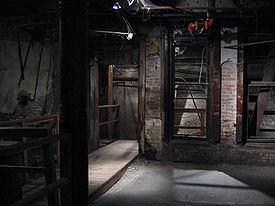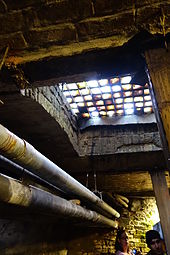Seattle Underground
| This article needs additional citations for verification. (August 2007) (Learn how and when to remove this template message) |
The Seattle Underground is a network of underground passageways and basements in downtown Seattle, Washington, United States that was ground level at the city's origin in the mid-19th century. After the streets were elevated these spaces fell into disuse, but have become a tourist attraction in recent decades.
Contents
History[edit]
Seattle's first buildings were wooden. On June 6, 1889 at 2:39 in the afternoon,[1] a cabinetmaker (Jonathan Edward Back),[2][3] accidentally overturned and ignited a glue pot. An attempt to extinguish it with water spread the burning grease-based glue. The fire chief was out of town, and although the volunteer fire department responded they made the mistake of trying to use too many hoses at once. With the subsequent drop in water pressure none of the hoses were effective and the Great Seattle Fire destroyed 31 blocks.[4]
While a destructive fire was not unusual for the time, instead of rebuilding the city as it was before, the response of the city leaders was to make two strategic decisions: first, that all new buildings must be of stone or brick, as insurance against a similar disaster in the future; and second to regrade the streets one to two stories higher than the original street grade. Pioneer Square had originally been built mostly on filled-in tidelands and, as a consequence, it often flooded. The new street level also assisted in ensuring that gravity-assisted flush toilets that funneled into Elliott Bay did not back up at high tide.
For the regrade, the streets were lined with concrete walls that formed narrow alleyways between the walls and the buildings on both sides of the street, with a wide "alley" where the street was. The naturally steep hillsides were used, and through a series of sluices material was washed into the wide "alleys", raising the streets to the desired new level, generally 12 feet (3.7 m) higher than before, in some places nearly 30 feet (9.1 m).
At first pedestrians climbed ladders to go between street level and the sidewalks in front of the building entrances. Brick archways were constructed next to the road surface, above the submerged sidewalks. Skylights with small panes of clear glass (which later became amethyst-colored because of manganese in the glass) were installed, creating the area now called the Seattle Underground.
When they reconstructed their buildings, merchants and landlords knew that the ground floor would eventually be underground and the next floor up would be the new ground floor, so there is very little decoration on the doors and windows of the original ground floor, but extensive decoration on the new ground floor.
Once the new sidewalks were complete, building owners moved their businesses to the new ground floor, although merchants carried on business in the lowest floors of buildings that survived the fire, and pedestrians continued to use the underground sidewalks lit by the glass prisms (still seen on some streets) embedded in the grade-level sidewalk above.
In 1907 the city condemned the Underground for fear of bubonic plague, two years before the 1909 World Fair in Seattle (Alaska-Yukon-Pacific Exposition). The basements were left to deteriorate or were used as storage. Some became illegal flophouses for the homeless, gambling halls, speakeasies, and opium dens.
Only a small portion of the Seattle Underground has been restored and made safe and accessible to the public on guided tours.
Bill Speidel's Underground Tour[edit]
In 1965, local citizen Bill Speidel realized there might be interest (and profit) in the subterranean ruins. He established "Bill Speidel's Underground Tour" and took customers on a tour of what was left underneath Pioneer Square, paying rent to the building owners for the privilege of doing so. He peppered his tour patter with tall tales from Seattle's history (some more factual than others), giving the tour an amusing counterculture feel that made it an "underground" tour in every sense of the word.
Over the years the tour has become more popular, it runs year round with tours offered seven days a week except Thanksgiving and Christmas Day. Over the years, the underground structures have been steadily refurbished to be more visually appealing, however, the underground seen on Bill Speidel's Underground Tour remains authentic to when it was discovered by Bill in 1965. The tour remains a popular attraction for visitors and locals alike.
In 2004, Bill Speidel Enterprises Inc. began the adults-only Underworld Tour, incorporating discussions of prostitution, the opium trade, and other less family-friendly elements of Seattle's early history.
Popular culture[edit]
The Seattle Underground was featured prominently in the 1973 television movie The Night Strangler (starring Darren McGavin). The film was a sequel to the highly successful 1972 TV movie The Night Stalker and brought a surge in tourism to the Underground afterward. Many people have claimed seeing ghosts on the tour and thus it became one of the sites of many ghost hunter television shows.
A fictional version of the Seattle Underground was used as a setting in the Scooby-Doo series in the 1976 episode "A Frightened Hound Meets Demons Underground".
The Seattle Underground is shown in an episode of Jem and the Holograms, the animated children's series from the 1980s. In the episode titled 'The Jazz Player' secondary character Aja Leith finds herself cornered in the Seattle underground as she runs from loan sharks pursuing Joey London, who Aja is trying to reunite with his old Jazz band mates who are trying to clinch a new record deal.
See also[edit]
- Catacombs of Rome
- Edinburgh Vaults
- Manchester Cathedral Steps
- Raising of Chicago
- Shanghai tunnels (less commonly known as the Portland Underground, in Portland, Oregon)
- Underground Atlanta
- Underground City (underground features in cities around the world)
References[edit]
- ^ Los Angeles Daily Herald., Seattle in Ashes, June 07, 1889, p.5
- ^ Hugh McGough, "The Great Seattle Fire—Don't Blame Jimmie McGough"
- ^ Seattle Post-Intelligencer, The P-I error that changed Seattle history, July 22, 2011
- ^ Los Angeles Daily Herald., The Seattle Fire, June 08, 1889, p.5.
Further reading[edit]
- Doc Maynard, The Man Who Invented Seattle. 1978, USA: Nettle Creek. ISBN 0-914890-02-6.
- Sons of the Profits. 1990, USA: Nettle Creek. ISBN 0-914890-06-9.
External links[edit]
| Wikimedia Commons has media related to Seattle Underground. |




